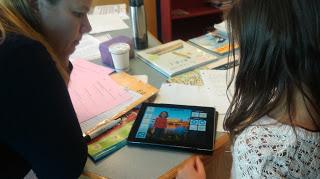Using The "TIM Matrix" For Identifying Best Practices For Digital Learning-Authentic Learning With The iPad In 5th Grade

I have chosen the "TIM Matrix" as a tool to look more closely at how technology is used across educational settings and with a variety of instructors in my district. By selecting a tool like this I have also selected to get down to the nitty gritty of what I feel is valuable with the integration of technology and also what best practices I can extract from our current practice.
I recently walked into a 5th grade classroom for a 10 minute observation. The teacher was working on a multi layered project with students using multiple apps on the ipad to have students create presentations which present their research on different states. To give a background on how I am framing my view I am looking to select a level of how the students are using the technology and the instructor’s level of integrating it. With the way I am using TIM, I am looking at these two components and selecting a level. I am then doing a general observation of the teachers practice and students engagement.
In this lesson I observed:
The teacher is working with individual students to create guided tours using the Tellegami App on the iPad. Students are using a guide sheet with questions to collect their research and then answer questions about their state. The questions include topics such as the longitude, latitude and continent. There are also questions about the land forms existing in the state such as rivers and mountains. Students are also researching the natural resources and climate of their chosen state such and industries. Students are also identifying a few points of interest and famous people from the state.
It is clear the teacher has collaborated with the subject area teacher before . They are able to have discussions about web based resources and parts of the lesson which go beyond surface level use of technology.
The title of this project is "Interactive State Tour Project".
- They create a Telegami app to create a video introducing the state and location.
- Create a Piccollage about a landmark.
- Create a resources page in Google Docs.
- Create a Chatterpix of a famous person from the state.
- Create a map outline with QR codes linking to the resources developed.
Students are working collaboratively(paired groups of varying sizes), emailing their videos and re-sending artifacts from the lesson.
Students are engaged with the lesson(asking questions, discussing content) and are making the connections with the content.
Teacher has assisted students with emailing the resources and helping them put the artifacts together in terms of sizing and organizing images.
Teacher has an organized folder of materials from the lesson.
She is discussing the components (completed parts,student progress) of the lesson with the teacher.
Teacher works with a student to locate resources on an iPad and ensures the student has backed up the video.
Teacher arranges with a student extra time to finish her project that did not show up as saved on the device.
Teacher checks on the script (student created written narrative) and tells the student she will see her in the morning.
Using the TIM Matrix has enabled me to look more closely at defining the best practices of the teachers and also how these practices influence student learning. Let me explain below and identify key components of this lesson which supported these descriptions.
Level Of Technology Integration Into The Curriculum
Transformation-At the Transformation level, students use technology tools flexibly to achieve specific learning outcomes. The students have a conceptual understanding of the tools coupled with extensive practical knowledge about their use. Students apply that understanding and knowledge, and students may extend the use of technology tools. They are encouraged to use technology tools in unconventional ways and are self-directed in combining the use of various tools. The teacher serves as a guide, mentor, and model in the use of technology.
Observation Evidence Of Transformation:
- Multiple apps used in the projects for creation. 5 applications used at varying times.
- Students are creators and are asked to use the apps to display their research and presentation soft skills. The focus here is more on how each app was used for a specific purpose than the quantity.
- Kids backup and manage backup files of student work. Students show ownership of their project and utilize project management skills
Characteristics Of Learning Environment
Authentic-The Authentic attribute involves using technology to link learning activities to the world beyond the instructional setting. This characteristic focuses on the extent to which technology is used to place learning into a meaningful context, increase its relevance to the learner, and tap into students' intrinsic motivation.
Observation Evidence Of Authentic Learning Environment:
- Students are self directed and allowed to work on different phases. In this lesson students were in a variety of phases and has dedicated a different level of craftsmanship to their project skills.
- Students can manage their work level.
- Authentic Project. Students are asked to solve a real world problem. In this case a presentation of the geography of an area with valid and reliable sources in a way which uses multimedia.
- Collaborated with teacher. The teacher has developed a working relationship in which each accountability in the success of the project. Each can bring their strengths to the table.
Utilizing the TIM Matrix helped me identify the key elements of collaboration and authentic learning that drives this lesson. The technology supports the teachers strategies and enables the students to more independent learning opportunities and diverse teamwork. It is great to see this in our classrooms and is even better to share with my Digital Learning Specialists the best practices that we can think about as we develop lessons and co-teach with other teachers.
- Log in to post comments

